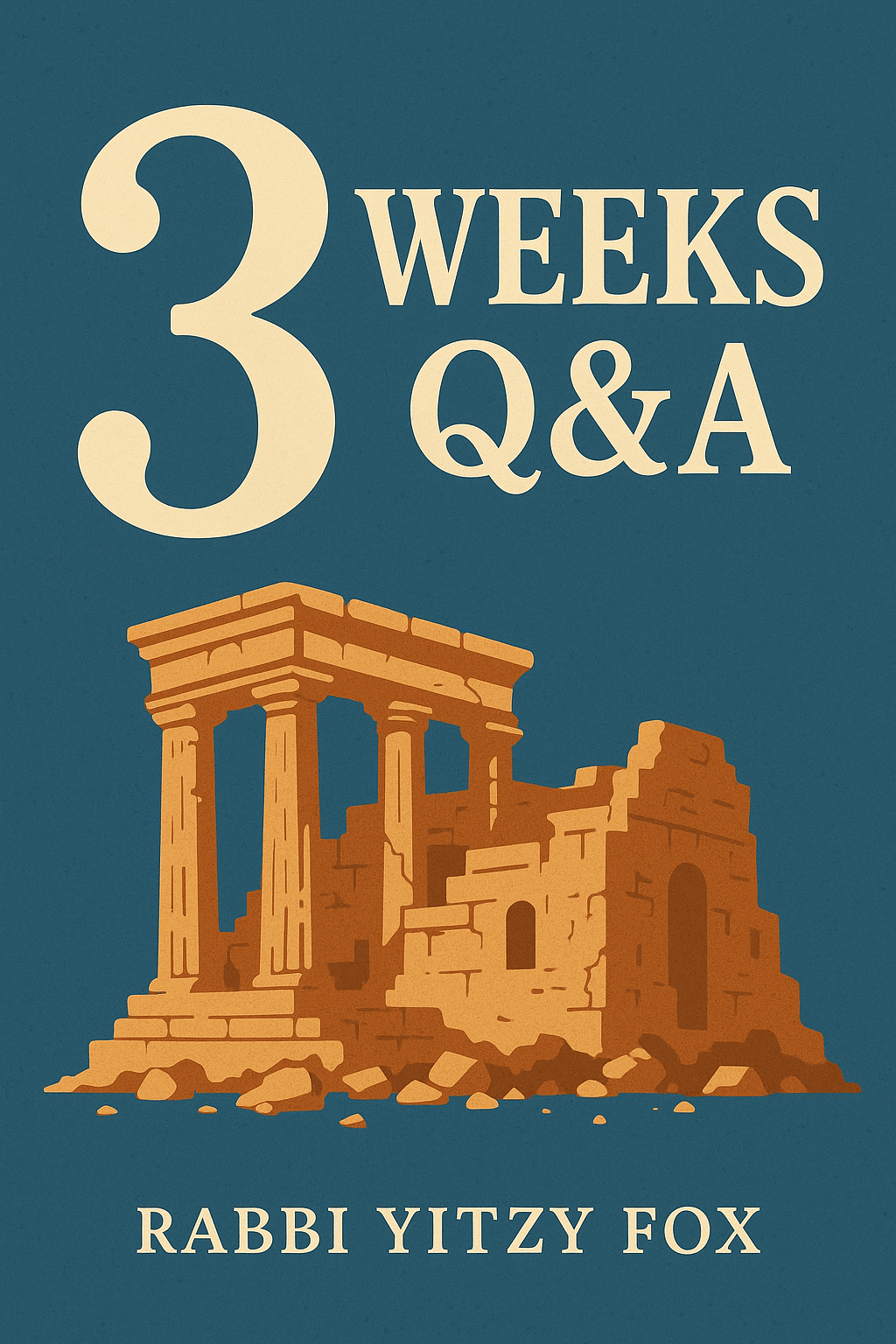Questions:
1) What are the 5 events that happened on Shiva Asar B’Tamuz according to Chazal?
2) Which nation destroyed the first Beis Hamikdash? Which nation destroyed the second Beis hamikdash?
3) Which Beis Hamikdash stood for longer, the first or the second?
4) Who wrote Megilas Eichah?
5) When were the walls of Yerushalayim breached during the first Beis Hamikdash?
6) What are some of the reasons given by Chazal for the destruction of the first Beis Hamikdash?
7) What is the reason given by Chazal for the destruction of the second Beis Hamikdash?
8) What are the 5 tragedies that occurred on Tisha B’av according to Chazal?
9) Which 2 mitzvos are prohibited or restricted on Tisha B’av?
10) Which historical tragedies that occurred after the events of the Second Beis Hamikdash are commemorated in the Kinnos, and which Kinnos refer to them?
11) What is the significance of the 10th of Av?
Answers:
1) 1. The breaking of the Luchos 2. The discontinuing of the Korban Tamid 3. The walls ofYerushalayim were breached during the 2nd beis Hamikdash 4. Burning of a Torah scroll by Apostomus 5. An idol placed in the Sanctuary. (Mishnah Taanis 4:6)
2) a) The Babylonians, led by their ruler, Nevuchadnezzar. (Yirmiyahu 52:12-16)
b) The Romans, led by their general, Titus. (Gemara Gittin 55b-56b)
3) The 2nd Beis Hamikdash, which stood for 420 years. The first Beis Hamikdash stood for 410 years. (Yoma 9a; Eiruchin 12b)
4) Yirmiyah. He initially instructed Baruch ben Neiri to write it down the nevuah whileYirmiyah was imprisoned but that scroll was ripped up and thrown into a fire by Yehoyakim. Yirmiyah rewrote Eichah and added another perek. (Bava Basra 14a; Yirmiyah 36:1-32)
5) 9th of Tamuz. (Taanis 29b; Yirmiyah 52:6-7; See Yerushlami Taanis 4:5)
6) There are many reasons given in Chazal, here are a few: 1. Shfichas Damim, Avodah Zarah, and Gilui Arayos. (Yoma 9b) 2. Failure to properly keep Shemitah. (Shabbos 119b) 3. Because we did not rebuke each other (Shabbos 119b) 4. The desecration of Shabbos (ibid) 5. Failure to recite Birchas Hatorah. (Nedarim 81a; See Shabbos 119b for additional reasons)
7) Sinas Chinum – baseless hatred. (Yoma 9b)
8) 1. The decree that Bnei Yisrael would remain in the wilderness because of the spies’ evil report. 2. The Destruction of the First Temple 3. The Destruction of the Second Temple 4.The capture of Beitar after Bar Kochba’s revolt was put down 5. The plowing of the Temple Mount (Taanis 4:6).
9) 1. Torah learning is generally prohibited, except for sections related to mourning or the themes and events of Tisha B’Av—such as Megillas Eichah, Iyov or the Churban Gemaras. It is also permitted to learn the Gemara in Moed Katan that discuss the laws of aveilus (Shulchan Aruch OC 554:1-2).
2. Tefilin. Although most poskim require a person to wear Tefilin on Tisha B’av, the Smag (assei 3) is of the opinion that one should not put on Tefilin on Tisha B’av just as a mourner does not put on tefillin on the first day of mourning. The Shulchan Aruch (555:1) rules that we delay putting on Tefilin (and Talis) until Mincha.
10) 1. The burning of 24 wagonloads of Talmudic manuscripts in Paris (1242) is lamented in “Sha’ali Serufah Ba’ash”. 2. The Crusade massacres of 1096, where Jewish communities in Worms, Mainz, and Speyer were martyred, are mourned in “Av HaRachamim”, “Mi Yiten Roshi Mayim”, and “Zechor Bris Avraham”. 3. The Asarah Harugei Malchus (The Ten Martyrs), such as Rabbi Akiva, who were executed by the Romans, are memorialized in “Eleh Ezkerah” and “Erzai HaLevanon”. 4. The Spanish Expulsion (1492) is referenced in “Sha’alu Shlom Yerushalayim”. 5. Many communities recite kinnos for the Chmielnicki massacres which devastated Eastern Europe Jewry (1648–49). The kinah ofAish Tukad B’kirbi was authored by the Shach, who spent much of his life fleeing from the Cossacks. 6. The kinah of Balayl Zeh Yivkeiyun details the crushing defeat and subsequent massacre that happened in Beitar 65 years after the destruction of the Beis Hamikdash. 7. Some communities added kinnos relating to the atrocities of the Holocaust.
11) It was the day that most of the 1st Beis Hamikdash was burned. Although the fast was established on Tisha B’av because that is when the Beis Hamikdash was set on fire, we do not eat meat, drink wine, cut hair, bathe or launder clothes, on the 10th of Av until Chatzos. (Taanis 29a; Rama 558:1, Mishna Berurah; Sefardim keep restrictions the entire day)








HOT OFF THE PRESS